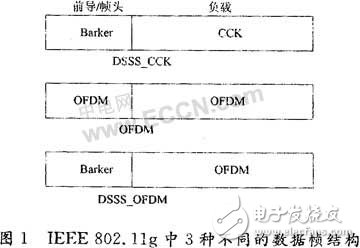In the IEEE 802.11g physical layer. The baseband processor handles three different frame structures: DSSS_CCK (Direct Sequence Spread Spectrum Complement Keying), OFDM (Frequency Division Multiplexing), and DSSS_OFDM (Direct Sequence Spread Spectrum Orthogonal Frequency Division Multiplexing). Figure 1 shows these three different frame structures. Therefore, when designing the receiver, we must first consider the detection and discrimination of the data frame, because the correctness and accuracy of the detection algorithm determine the upper limit of the performance of the entire receiver.

Therefore, when designing a receiver, it is necessary to consider the detection of different types of signals. At the front end of the receiver, the received signal is detected first, and then the preamble format is determined to perform the remaining processing.
2 802.11g standard frame header formatIn the IEEE 802.11g standard, the frame header can take one of two forms: Orthogonal Frequency Division Multiplexing (OFDM) type and Direct Sequence Spread Spectrum (DSSS) type.
In the frame header of the OFDM type, at the forefront of the baseband signal is a short preamhie preamble, which is composed of 10 identical symbol sequences, and the period of one symbol is 0.8 μs. Each symbol sequence consists of 16 points, each of which can be viewed as a complex number with real and imaginary parts, the header string being transmitted at 20 M.
In the frame header of the DSSS type, the preamble signal is transmitted at a rate of 11 M, and is composed of a plurality of in-phase or inverted symbols periodically, with a period of 1 μs. A symbol consists of 11 points, each of which can be regarded as a complex number with real and imaginary parts. The most basic role of the preamble is to indicate the arrival of the packet. In fact, the detection of the preamble is received. ready. Design detection algorithms should consider two aspects of indicators: effectiveness and reliability.
First of all, it cannot be detected when a packet arrives. This is called frame loss and the network quality will drop. Increasing the detection rate when a packet arrives is to improve the effectiveness. Secondly, it is not possible to make an erroneous arrival indication when there is no packet arrival, or to misjudge one packet without another, causing waste of network resources. To prevent this from happening, it is necessary to improve the reliability of detection. In addition to being used for receiving signal detection, wireless LAN devices also use preamble to perform other receiving tasks. For example, in the case of an OFDM type preamble, the receiver also uses it for automatic gain control (AGC), frequency offset estimation, and the like.
Therefore, the preamble detection must be performed while the AGC is being adjusted. The AGC adjustment algorithm can be regarded as an iterative process. The purpose is to adjust the signal amplitude to the conversion range of the A/D converter. This makes the input signal amplitude of the detection algorithm constantly changing, so the detection algorithm must Can handle this situation.
We are dedicated charging solution Manufacturer since 2005.
Supply various Power Station including Portable Power Stations, Solar Power Generators, Smallest Generator etc.
Manufacturing high quality products for customers according to international standards, such as CE ROHS FCC REACH UL SGS BQB etc.
To constantly offer clients more innovative products and better services is our consistent pursuit.
portable power stations for camping, solar pow er stations, jackery portable power station
TOPNOTCH INTERNATIONAL GROUP LIMITED , https://www.itopnoobluetoothes.com